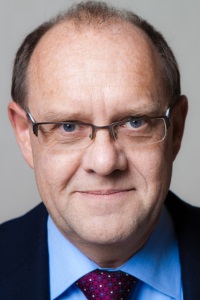 Eckert Jürgen Hartmut
Eckert Jürgen Hartmut Doctor of engineering, research supervisor of NUST MISIS project “Smart metal/polymer structures for biomedical applications”, full member of the Austrian Academy of Sciences, professor, director at the Erich Schmid Institute of Materials Science of the Austrian Academy of Sciences (Austria).
Research Interests
Metastable metallic systems; promising nanostructured high performance materials; amorphous alloys and composites based thereon; improvement of strength and other functional features of metallic composites.
2020 — present: research supervisor of project "Smart metal/polymer structures for biomedical applications, NUST MISIS.
2015: director at the Erich Schmid Institute of Materials Science, Austrian Academy of Sciences, Leoben (Austria) and chair at the Department of Materials Physics of the State University in Leoben (Austria)
2015: professor, Department of Materials Sciences, Leoben, Austria.
1990: PhD. Diploma thesis cum laude. University Erlangen-Nürnberg and Siemens Research Laboratories, Erlangen; Research Center Jülich, Germany.
1986: University Erlangen-Nürnberg, Germany.
1981: high school in Pegnitz, Germany.
Professor Jürgen Eckert is a world leading specialist in materials science and biomaterial physics. The main areas of his research are physics of materials, metastable materials, correlations of structure and properties, as well as structural and physical properties of promising materials.
Professor Jürgen Eckert is the supervisor and participant of over 50 scientific projects through his entire scientific career. Including
- Development of new biocompatible composite materials based on multicomponent alloys/ European Research Council under the ERC/2015-2021/ (Advanced Grant INTELHYB, ERC-2013-ADG-340025);
- Synthesis and Investigation of Biocompatible and Biodegradable Materials / International research collaboration of
ICC-IMR, Tohoku University/2019-2021/ (project number: 2019PJT2); - International Training Network Vitrified Metals Technologies and Applications in Devices and Chemistry (VitriMetTech) / Marie Curie ERC grant /
2015-2017 /; - Academic-Industrial Initial Training. Network on Innovative Biocompatible Titanium-base Structures for Orthopaedics / Marie Curie ERC grant /
2011-2014 /; - Rapid solidification and advanced manufacturing of Cu-based shape memory alloys / Gottfried Wilhelm Leibniz Award of the German Research Foundation (DFG) /
2009-2016 /; - Development of novel titanium alloys for improving lock-in and fracture healing in diseased bones / SFB/Transregio 79 (DFG) (Project M1)/
2014-2018.
- B. Sarac, Y.P. Ivanov, A. Chuvilin, T. Schoberl, M. Stoica, Z. Zhang, J. Eckert Origin of large plasticity and multiscale effects in iron-based metallic glasses, Nature Communications, 9 (2018) 1333 / The large plasticity observed in newly developed monolithic bulk metallic glasses under quasi-static compression raises a question about the contribution of atomic scale effects;
- L. Zhang, H.F. Zhang, X.B. Ren, J. Eckert, Y.D. Wang, Z.W. Zhu, T. Gemming, S. Pauly Amorphous martensite in beta-Ti alloy, Nature Communications, 9 (2018) 506 / Martensitic transformations originate from a rigidity instability, which causes a crystal to change its lattice in a displacive manner;
- M. Bonisch, A. Panigrahi, M. Stoica, M. Calin, E. Ahrens, M. Zehetbauer, W. Skrotzki, J. Eckert Giant thermal expansion and alpha-precipitation pathways in Ti-alloys, Nature Communications, 8 (2017) 1429 / Ti-alloys represent the principal structural materials in both aerospace development and metallic biomaterials;
- I.V. Okulov, I.V. Soldatov, M.F. Sarmanova, I. Kaban, T. Gemming, K. Edstrom, J. Eckert, Flash Joule heating for ductilization of metallic glasses, Nature Communications, 6 (2015) 7932 / Metallic glasses (MGs) inherit their amorphous structure from the liquid state, which predetermines their ability to withstand high loads approaching the theoretical limit;
- Q. Luo, G.T. Garbarino, B.A. Sun, D.W. Fan, Y. Zhang, Z. Wang, Y.J. Sun, J. Jiao, X.D. Li, P.S. Li, N. Mattern, J. Eckert, J. Shen, Hierarchical densification and negative thermal expansion in Ce-based metallic glass under high pressure, Nature Communications, 6 (2015) 5703 / The polyamorphsim in amorphous materials is one of the most fascinating topics in condensed matter physics.
The number of publications is more than 1,200. Please find the full list: link, link, link.
Jürgen Hartmut Eckert has supervised more than 40 PhD students and is actively involved in EU-ITN-Networks, promoting gender balance (e.g. through the EU-programmes WomenInNano and DIVERSITY) etc.His contribution is about teaching/inspiring young scientists. Many of them now hold leading positions in the academia (faculty positions) and in companies, and run very successful research groups in their home countries (e.g. in the USA, Egypt, Korea, Japan, Russia).
Teaching
- Montanuniversität, Leoben (Austria), materials science, materials physics, since 2015.
- University of Vienna (Austria), physics of nanostructured materials,
2009-2012. - Darmstadt University of Technology (Germany), physical metallurgy,
2003-2006. - Michigan Technological University (USA), materials science and engineering,
2002-2005. - Dresden University of Technology, materials science,
1997-2000.
Fellow of the Materials Research Society (MRS) since 2018, member of the European Academy of Sciences since 2017, corresponding member of the Section Mathematics-Natural Sciences of the Austrian Academy of Sciences since 2017.